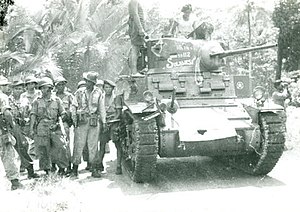Indonesian Revolution
| Indonesian Revolution | |||||||
|---|---|---|---|---|---|---|---|
| Part of Great War II and the Cold War | |||||||
 | |||||||
| |||||||
| Belligerents | |||||||
|
1954-1957 1957-1960 Supported by: |
1954-1957
1957-1960 | ||||||
The Indonesian Revolution, sometimes known as the War of National Liberation was an armed conflict that intersected with the Great War II. Beginning as a series of rebellions against the Japanese protectorate of the Indonesian Union from left-wing forces led by the Communist Party of Indonesia (PKI) and the Islamist Darul Islam movement after the defeat of Japan by Allied forces it became a civil war between the PKI-dominated Central Indonesian National Committee (KNIP) and the western supported Revolutionary Government of the Republic of Indonesia (PRRI). The revolution would end with the victory of the KNIP backed by the United Commonwealth and China over the Sierran-British supported PRRI.
During the initial part of the conflict (1954-1957) fighting was marked by firm Japanese control over urban areas in Malaya, Sumatra and Java but a worsening collapse in authority in rural areas which came under PKI influence in Java and Malaya and Darul Islam influence in northern Sumatra. Following the surrender of Japan PKI backed groups took over cities such as Yogyakarta, Bandung and Penang where they would eventually consolidate control. International interventions would sustain the PRRI for a period but the loss of Jakarta in 1959 and Kuala Lumpar in 1960 would herald the end of the revolution and military victory of the PKI forces.
The revolution is an important event in Indonesian history bringing an end to colonial rule in the country and the beginning of the modern People's Republic.
- E-class articles
- Altverse II
- 1954 in Indonesia
- 1955 in Indonesia
- 1956 in Indonesia
- 1957 in Indonesia
- 1958 in Indonesia
- 1959 in Indonesia
- 1960 in Indonesia
- 20th-century conflicts
- 20th-century revolutions
- Aftermath of Great War II in Indonesia
- Cold War
- Communist revolutions
- History of socialism
- Indonesia–Japan relations
- Proxy wars
- Separatism in Indonesia
- Separatism in Japan
- Uprisings during Great War II
- Wars involving the People's Republic of China
- Wars involving Indonesia
- Wars involving Japan
- Wars involving the Kingdom of Sierra
- Wars involving Thailand
- Wars involving Tondo
- Wars involving the United Commonwealth
- Wars involving the United Kingdom
- Wars of independence